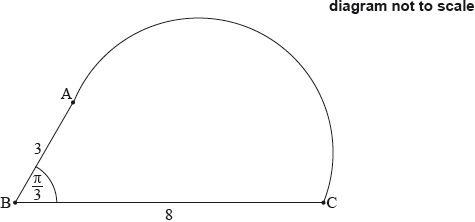| Date | May 2022 | Marks available | 3 | Reference code | 22M.2.SL.TZ1.7 |
| Level | Standard Level | Paper | Paper 2 | Time zone | Time zone 1 |
| Command term | Find | Question number | 7 | Adapted from | N/A |
Question
All lengths in this question are in centimetres.
A solid metal ornament is in the shape of a right pyramid, with vertex and square base . The centre of the base is . Point has coordinates and point has coordinates .
The volume of the pyramid is , correct to three significant figures.
Find .
Given that , find .
Find the height of the pyramid, .
A second ornament is in the shape of a cuboid with a rectangular base of length , width and height . The cuboid has the same volume as the pyramid.
The cuboid has a minimum surface area of . Find the value of .
Markscheme
attempt to use the distance formula to find (M1)
A1
[2 marks]
METHOD 1
attempt to apply cosine rule OR sine rule to find (M1)
OR (A1)
A1
METHOD 2
Let be the midpoint of
attempt to apply right-angled trigonometry on triangle (M1)
(A1)
A1
[3 marks]
METHOD 1
equating volume of pyramid formula to (M1)
(A1)
A1
METHOD 2
Let be the midpoint of
(M1)
(A1)
A1
[3 marks]
(A1)
A1
Note: Condone use of .
attempt to substitute into their expression for surface area (M1)
EITHER
attempt to find minimum turning point on graph of area function (M1)
OR
OR (M1)
THEN
minimum surface area A1
[5 marks]
Examiners report
Parts (a), (b) and (c) were completed well by many candidates, but few were able to make any significant progress in part (d).
In part (a), many candidates were able to apply the distance formula and successfully find AV. However, a common error was to work in two-dimensions and to apply Pythagoras' Theorem once, neglecting completely the z-coordinates. Many recognised the need to use either the sine or cosine rule in part (b) to find the length AB. Common errors in this part included: the GDC being set incorrectly in radians; applying right-angled trigonometry on a 40°, 40°, 70° triangle; or using as the length of AX in triangle AVX.
Despite the formula for the volume of a pyramid being in the formula booklet, a common error in part (c) was to omit the factor of from the volume formula, or not to recognise that the area of the base of the pyramid was .
The most challenging part of this question proved to be the optimization of the surface area of the cuboid in part (d). Although some candidates were able to form an equation involving the volume of the cuboid, an expression for the surface area eluded most. A common error was to gain a surface area which involved eight sides rather than six. It was surprising that few who were able to find both the equation and an expression were able to progress any further. Of those that did, few used their GDC to find the minimum surface area directly, with most preferring the more time consuming analytical approach.




